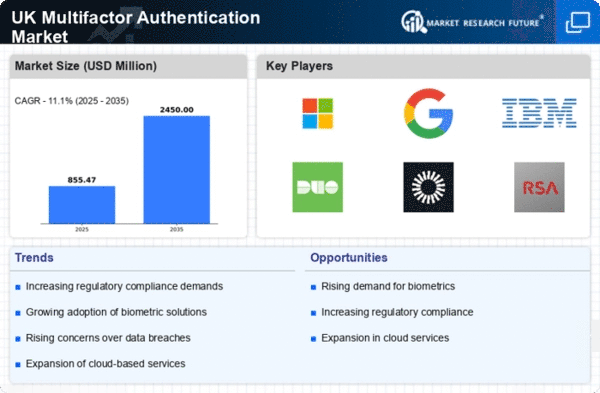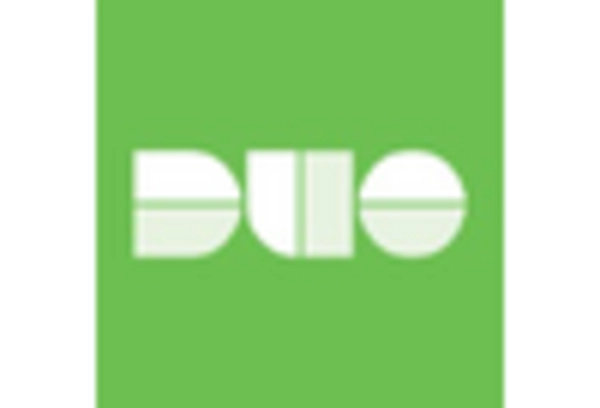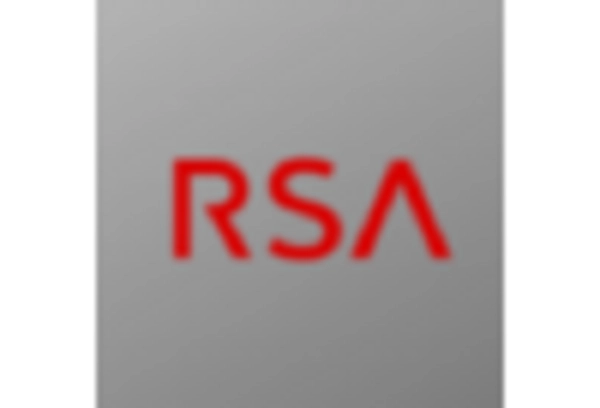Rise of Remote Work Culture
The shift towards remote work has fundamentally altered the landscape of cybersecurity, thereby impacting the multifactor authentication market. With a growing number of employees accessing corporate networks from various locations, the need for secure access solutions has intensified. In the UK, it is estimated that over 40% of the workforce is now engaged in remote work, which has led organizations to implement multifactor authentication to protect sensitive data. This trend is indicative of a broader recognition of the vulnerabilities associated with remote access. As companies seek to mitigate risks, the multifactor authentication market is poised for growth, with businesses increasingly investing in solutions that ensure secure access to their systems. The emphasis on employee training and awareness regarding cybersecurity best practices further complements this trend, reinforcing the importance of multifactor authentication in safeguarding corporate assets.
Growing Awareness of Data Privacy
In recent years, there has been a marked increase in awareness surrounding data privacy, significantly influencing the multifactor authentication market. With high-profile data breaches making headlines, consumers and businesses alike are becoming more vigilant about protecting personal information. In the UK, regulatory bodies have introduced stringent data protection laws, compelling organizations to adopt multifactor authentication as a means of compliance. The Information Commissioner's Office (ICO) has reported that businesses implementing such measures can reduce the risk of data breaches by up to 50%. This growing emphasis on data privacy not only drives the adoption of multifactor authentication solutions but also fosters a culture of accountability among organizations. As consumers demand greater transparency and security, the multifactor authentication market is likely to expand, with businesses prioritizing the implementation of robust security measures to safeguard sensitive data.
Increasing Demand for Secure Transactions
The multifactor authentication market is experiencing a notable surge in demand for secure transactions, particularly in the financial sector. As online banking and e-commerce continue to expand, the necessity for robust security measures becomes paramount. In the UK, a significant portion of consumers, approximately 70%, express concerns regarding online fraud, prompting financial institutions to adopt multifactor authentication solutions. This trend is further supported by the fact that the UK government has implemented initiatives to enhance digital security, thereby driving the multifactor authentication market. The integration of biometric technologies, such as fingerprint and facial recognition, is also gaining traction, as these methods provide an additional layer of security. Consequently, the multifactor authentication market is likely to witness sustained growth as businesses prioritize safeguarding sensitive information and maintaining customer trust.
Increased Investment in Cybersecurity Infrastructure
The multifactor authentication market is witnessing a surge in investment aimed at enhancing cybersecurity infrastructure. Organizations across various sectors are recognizing the critical need to fortify their defenses against cyber threats. In the UK, it is reported that businesses are allocating approximately £5 billion annually towards cybersecurity initiatives, with a significant portion directed towards multifactor authentication solutions. This trend reflects a broader commitment to safeguarding sensitive information and ensuring compliance with regulatory requirements. As cyber threats become increasingly sophisticated, the multifactor authentication market is likely to benefit from this influx of investment, enabling the development of more advanced and effective security measures. Furthermore, the collaboration between public and private sectors in addressing cybersecurity challenges is expected to bolster the multifactor authentication market, fostering innovation and resilience in the face of evolving threats.
Technological Advancements in Authentication Methods
The multifactor authentication market is being propelled by rapid technological advancements in authentication methods. Innovations such as artificial intelligence and machine learning are enhancing the effectiveness of multifactor authentication solutions, making them more user-friendly and secure. In the UK, the adoption of these advanced technologies is expected to increase, as organizations seek to streamline their authentication processes while maintaining high security standards. For instance, AI-driven analytics can identify unusual login patterns, prompting additional authentication measures when necessary. This proactive approach not only strengthens security but also improves user experience, as customers are less likely to encounter friction during the authentication process. As technology continues to evolve, the multifactor authentication market is likely to benefit from the integration of these cutting-edge solutions, positioning businesses to better protect their digital assets.

















Leave a Comment